6 Factors Driving the Future of Work
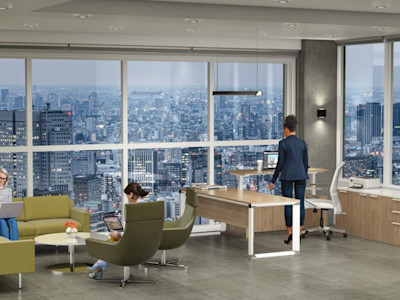
Since the evolution of office spaces began, various factors have driven the future of work. The motivation for change, ranging from aesthetics to functionality, has varied greatly. Additionally, the evolving landscape, shifting scope of work, and changing business perceptions continue to shape the future of work. At the same time, advancements in technology, even those originating outside the office, continue to transform our work processes. Flexibility introduces a new work-life balance.
A diverse workforce creates an environment with diverse ideas. As we move forward and approach our idea of the future of work, while looking forward to an even newer future of work, it’s important to identify what is shaping how we work and how we will work.
What is the Future of Work?
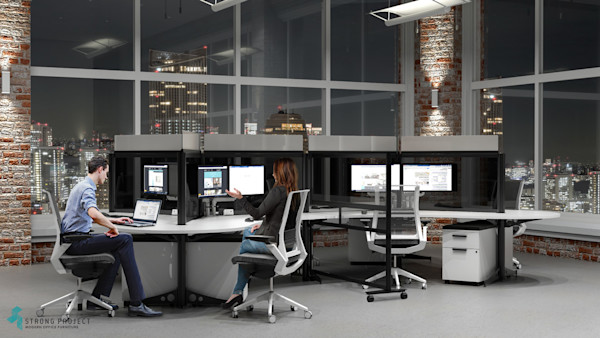
Learn more about how our modular workstations fit into the future of work
The future of work is how work changes. This involves the workforce, the workplace, and how companies develop their teams. As companies prepare to adapt to the future of work, it can be difficult to see which elements of business need to change.
Certain elements of the future of work might apply to some more than others. Larger companies might focus on developing a more diverse workforce. Companies with a large workload might benefit greatly from automation and AI. Companies that require less collaboration might consider a hyper-flexible or remote work model. However, the future of work isn’t a roadmap of what businesses need to do to adapt. The future of work is where the workforce and workplace will end up.
How Has the Future Work Come to Be?
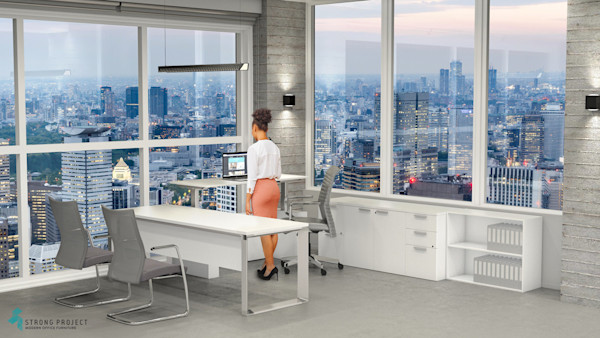
Find our collection of adjustable-height workstations
There are many areas that companies can focus their efforts on. Some are beneficial, but others have proven to be a product of science fiction. For example, only a decade ago, robots were poised to take over the workforce. Or we were going to end up in a hybrid or remote world driven by technology – at the time, this didn’t seem feasible. Although these ideas took a little more time to develop and didn’t play out the exact way we expected, the future of work is driven by needs and opportunities.
The future of work as we know it today is a blend of available and developing resources and an approach to office design that influences how we work. However, technology is continuing to develop. The hybrid and remote landscape is opening the talent pool immensely. Most importantly, companies are better understanding what is needed to keep employees productive, efficient, and satisfied.
The 6 Driving Factors of the Future of Work
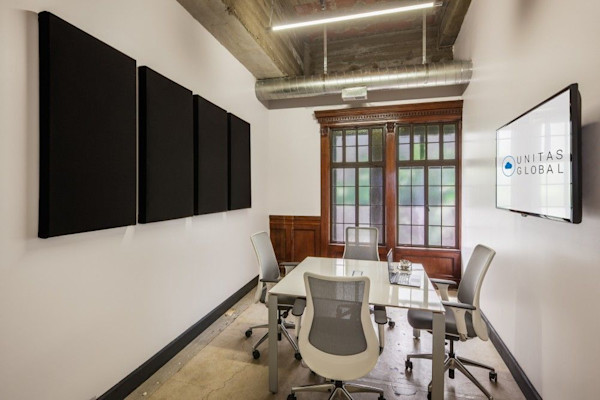
1. Technology
Tech is evolving faster and faster every day. Automation, specialized software, and AI have enhanced our abilities, our efficiency, and our decision-making. Technology facilitates communication. Tech saves employees from repetitive and mundane tasks. The resources available to companies have allowed them to operate in a more secure and confident fashion.
Technology is becoming more and more necessary to succeed in business. Tech is helping companies become more green and environmentally conscious, communicate efficiently, and create workplaces that are mutually beneficial to the employee as well as the employer.
2. Employee Needs
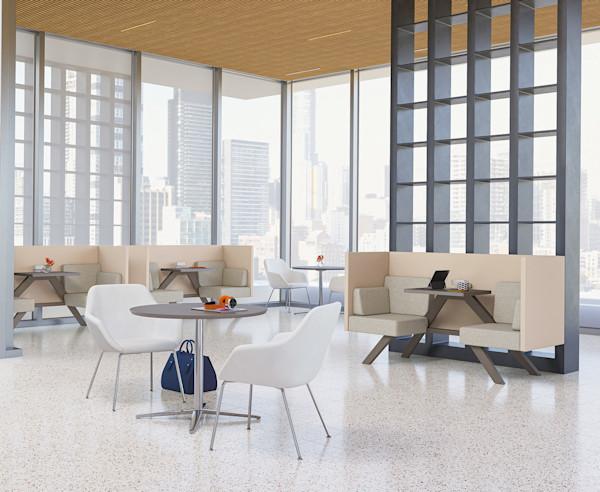
Build modern collaboration spaces to meet employee needs
Retaining excellent talent has become an obstacle to companies. Data from the U.S. Chamber of Commerce highlights a significant labor shortage. This has given employees more power in the workforce. Previously, the power was in the employees’ hands. Companies got by providing fewer benefits. They created a working environment that was just good enough. However, good talent is harder to find and even harder to retain.
Twenty years ago, the sprawling campuses of Google and other tech giants employed unorthodox workstyles. The nap pods. The recreation rooms. Catered lunches several times a week. All of these elements of their unique offices seemed to be a foreign concept. However, in larger companies with a more diverse talent pool, this is becoming more commonplace. The employee-centric take on office design and the job experience will only continue. As we work through this labor shortage, the way businesses treat their employees is becoming just as important as those they do business with.
3. Diversity
Creating a diverse workforce has become a priority for many companies. However, it’s moved beyond a social responsibility. It’s beyond race and gender. Diversity brings people into the workplace who have different experiences. Different problem-solving skills, different dynamics, and diverse workforces contribute to much more. Employees from many backgrounds offer unique perspectives. Building a diverse workforce can lead to a change in how companies work.
Diversity in the workplace can change how companies communicate with their customer base. Because of this, it can improve the working experience. The hybrid and remote work models open access to a talent pool not restricted by geographical location or capabilities. As diversity in business becomes the norm, we’ll continue to see companies develop new approaches to business.
4. Flexibility
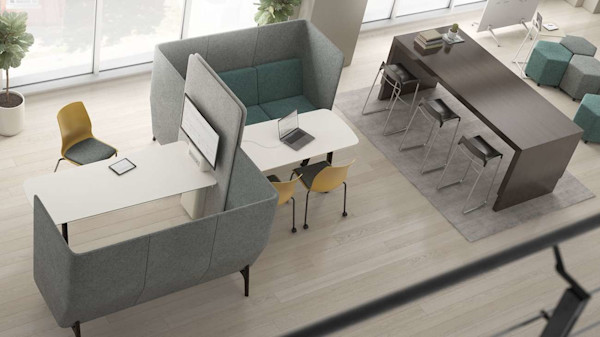
Design a multi-use space to ensure flexibility
A hot topic in the future of work has been flexibility. For a while, the hybrid model has been a perk for employees. An improved work-life balance, the ability to spend more time away from the office, and less employee monitoring have been something a large portion of the workforce would have a hard time turning down. However, it wasn’t until recently it became more normal. This happened to be a direct impact of the 2020 pandemic. A recent study featured in the Journal of Vocational Behavior discusses the psychology and the impact of a flexible workspace.
Many companies shifted to more hybrid work rather than in-person work. Even though this was out of necessity, for some industries, it has become the standard, and technology has made this possible. Even though there is still a struggle between employees and employers to return to work, for many, the flexible workplace isn’t going anywhere.
Flexible work arrangements are mirrored in adaptable workspace design. Multi-use spaces, multi-functional furniture, and spaces that serve many needs allow employees to create a space they need without having to settle for a desk and chair. As the future of work continues to change, it’s clear that flexibility isn’t going anywhere. It’s just how our idea of flexibility evolves.
5. Opportunity
Employees are looking for opportunities. Because of this, they want the chance to climb the corporate ladder. This shift may stem from the labor shortage and the increasing difficulty in finding quality talent. Maybe it’s companies investing in their employees to become a more integral part of the company.
Growth has become a focus in employee satisfaction, and it plays a large part in retention. In a world where companies have a social responsibility, develop initiatives around these responsibilities, or identify themselves around a cause, it’s important to have people who believe in building your brand’s identity. Because of this, giving employees these opportunities results in long-lasting, quality employment.
6. Office Design
The offices we work in play a major part in the future of work. Whether it’s the modern aesthetic or innovative concepts, your office is your identity. It’s how you work. Most importantly, it’s where you work. Office design is considered in all aspects of the future of work.
Tech-integrated offices, an office that meets employee needs, designs that appeal to a diverse group of people, hyper-flexible office spaces, and environments that let employees succeed, address all aspects of the future of work.
How Do You Build the Office for the Future of Work?
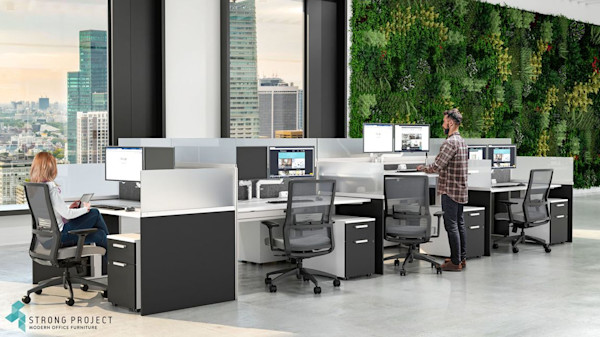
Build an office for comfort and functionality
StrongProject understands the importance of office design. For many companies, investing in an office space is a big leap. Whether you’re remodeling an existing space or starting over with a complete office build-out, many businesses have one shot to get it right. It can be an intimidating process. What pieces do you need? Will this office meet your needs 5 years down the road? Can it evolve with your business?
We know it can be a daunting process. However, StrongProject helps you make those decisions. From design to installation, we guide you through every step, ensuring your workspace aligns with both current and future needs. Do you need a blend of privacy and collaboration? Our modular workstations can meet those needs. Do you need private workstations? Our modern cubicles are the perfect solution. Our product collections range from collaboration furniture to acoustic pods to ergonomic adjustable height desks.
Get in touch today to discover how our Los Angeles-based design team can help you create an office built to evolve with your business.
If you’re interested in learning more about the future of work, check out this related post:



